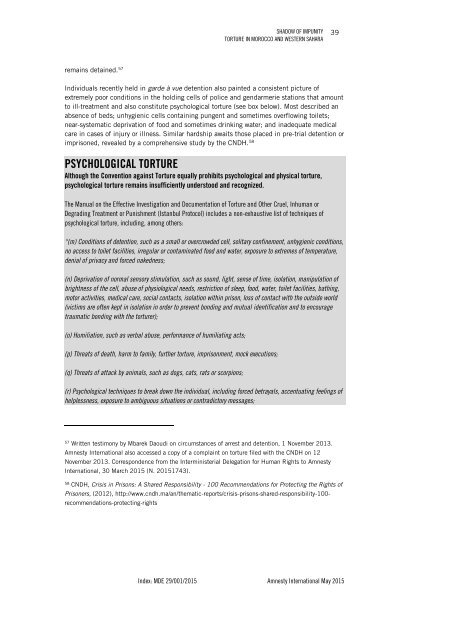38SHADOW OF IMPUNITYTORTURE IN MOROCCO AND WESTERN SAHARAIn practice, torture and other ill-treatment usually contain a blend of physical andpsychological violence which intertwine and overlap. In the two cases below, thepsychological pressure put on detainees to force them to incriminate themselves isparticularly salient.Gendarmes arrested student Yassine Lmsiah on 1 May 2014 in Fes in connection with thekilling of student Abderrahim Hasnaoui 53 and transferred him to judicial police custody. In awritten account of his garde à vue detention, 54 he stated that an officer threatened to torturehim and said he had previously tortured other students. The following day, Yassine Lmsiahsaid police officers beat him until he lost consciousness using “limb extension” – whereby astick is inserted behind the knees and the victim is then pulled and twisted by the armscausing intense pain and bruising. Yassine Lmsiah also alleged that the same officer whothreatened him on the first day threatened to arrest his sister and assault her in front of himin order to coerce him into signing an incriminatory statement. He said that when he stillrefused, police officers took him to his home and briefly arrested his sister, then assaultedhim again as they drove him back to the police station. There, officers reportedly insulted hissister in front of him, calling her a prostitute, causing him to hit his head against the wall infrustration. 55Mbarek Daoudi, a former soldier in the Moroccan army and supporter of self-determinationfor Western Sahara, and his two sons Brahim and Hassan, then 17, were arrested at theirhome in Guelmim on 28 September 2013 in relation to unrest following the dismantling ofthe Tizimi protest camp and the killing of a protester in a nearby town (see above). Theirfamily reported that officers forced them to strip naked in front of each other, beat them,fracturing one of Mbarek Daoudi’s ribs, and forced them to sign incriminating statements.Mbarek Daoudi lodged a written complaint with the CNDH. 56 However, judicial authorities didnot open an investigation or order a medical examination. Hassan Daoudi was releaseduncharged but Brahim Daoudi was convicted of theft and violent protest charges.Mbarek Daoudi was placed in pre-trial detention in Salé 1 Prison near Rabat to await trialbefore a military court on separate charges, including possession of ammunition without alicence and attempt to manufacture a weapon; he remained there in pre-trial detention for 17months. His lawyer said that in March 2015, authorities transferred him to Guelmim where acivilian court tried him on charges of possessing a knife with intent to cause harm, andwearing an official uniform without a licence. The court cleared him of the first accusationand convicted him of the second, imposing a fine of 1,000 dirhams (approximately US$100)and a three-month prison sentence increased to six months on appeal, his lawyer said. He53See Chapter 1.54Student movement struggles (blog), “Political prisoner Yassine Lemsiah, prisoner number 89587,Testimony about torture”, 4 June 2014, http://vdbunem.blogspot.co.uk/2014/06/89587.html55Interview, Fes, 29 May 2014.56Amnesty International accessed a copy of the complaint received by the CNDH on 12 November2013.Amnesty International May 2015 Index: MDE 29/001/2015
SHADOW OF IMPUNITYTORTURE IN MOROCCO AND WESTERN SAHARA39remains detained. 57Individuals recently held in garde à vue detention also painted a consistent picture ofextremely poor conditions in the holding cells of police and gendarmerie stations that amountto ill-treatment and also constitute psychological torture (see box below). Most described anabsence of beds; unhygienic cells containing pungent and sometimes overflowing toilets;near-systematic deprivation of food and sometimes drinking water; and inadequate medicalcare in cases of injury or illness. Similar hardship awaits those placed in pre-trial detention orimprisoned, revealed by a comprehensive study by the CNDH. 58PSYCHOLOGICAL TORTUREAlthough the Convention against Torture equally prohibits psychological and physical torture,psychological torture remains insufficiently understood and recognized.The Manual on the Effective Investigation and Documentation of Torture and Other Cruel, Inhuman orDegrading Treatment or Punishment (Istanbul Protocol) includes a non-exhaustive list of techniques ofpsychological torture, including, among others:“(m) Conditions of detention, such as a small or overcrowded cell, solitary confinement, unhygienic conditions,no access to toilet facilities, irregular or contaminated food and water, exposure to extremes of temperature,denial of privacy and forced nakedness;(n) Deprivation of normal sensory stimulation, such as sound, light, sense of time, isolation, manipulation ofbrightness of the cell, abuse of physiological needs, restriction of sleep, food, water, toilet facilities, bathing,motor activities, medical care, social contacts, isolation within prison, loss of contact with the outside world(victims are often kept in isolation in order to prevent bonding and mutual identification and to encouragetraumatic bonding with the torturer);(o) Humiliation, such as verbal abuse, performance of humiliating acts;(p) Threats of death, harm to family, further torture, imprisonment, mock executions;(q) Threats of attack by animals, such as dogs, cats, rats or scorpions;(r) Psychological techniques to break down the individual, including forced betrayals, accentuating feelings ofhelplessness, exposure to ambiguous situations or contradictory messages;57Written testimony by Mbarek Daoudi on circumstances of arrest and detention, 1 November 2013.Amnesty International also accessed a copy of a complaint on torture filed with the CNDH on 12November 2013. Correspondence from the Interministerial Delegation for Human Rights to AmnestyInternational, 30 March 2015 (N. 20151743).58CNDH, Crisis in Prisons: A Shared Responsibility - 100 Recommendations for Protecting the Rights ofPrisoners, (2012), http://www.cndh.ma/an/thematic-reports/crisis-prisons-shared-responsibility-100-recommendations-protecting-rightsIndex: MDE 29/001/2015 Amnesty International May 2015


